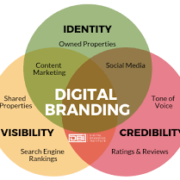Online Brand Credibility
In a time of increasing online competition, it’s tempting for companies to try flash-in-the-pan tactics to get noticed. For example, they can just underprice their competition to attract new consumers. Although that may result in a short burst of new sales, the rush-to-the-bottom approach is likely not sustainable. Establishing the credibility of your brand, so that consumers will be willing to pay a profit-yielding amount for your product or service, is a wiser long-term strategy.
Word-of-mouth advertising has always been essential to building brand credibility. Today’s mouthpieces are social media reviews and ratings, influencers and online content.
An expanding digital world is humming with billions of voices, all asking for consumers to trust and believe in their brands. Rising above the noise can be challenging. Consider these three keys to helping your brand’s online credibility.
Build a Digital Presence to Gain Brand Recognition
Begin with a website that looks great and works well on a range of devices. Fill it with high-quality content that focuses on building brand credibility. Your website needs to be optimized for search so your content will march upward in search engine rankings over time.
While you’re implementing your content strategy, build a complementary social media presence. As you expand onto new platforms, you’re expanding the ways your content can be found, accessed and shared. Clicks, retweets, shares, likes, reviews and ratings are all means of growing your followers.
Building an audience takes time and effort.
Follow Through on What You Promise
Prospects become customers when they agree to take a risk on your brand and buy what you’re selling. So don’t sell them short. If you don’t follow through on the promises you made, they’re going to walk away.
You promised customers that you would solve a problem, produce a quality offering and provide service after the sale. Customers took a chance on you based on what they learned about your brand online. They read your content, customer reviews and product information. Once they take a leap of faith, it’s up to you to earn their trust.
Brand credibility is all about providing what you promised, so you need to deliver. Even better, give customers more than they bargained for. That will keep your brand top of mind—even if you are not number one in search rankings—the next time they’re ready to buy.
Leverage Brand Loyalty
Your digital content and marketing strategy have gotten your brand noticed. A prospect has converted to a customer. Now it’s time to give that customer reasons to stay loyal—and to leverage that loyalty into further growth.
Highlight positive customer reviews and ratings on your website and social media to make sure prospects can see them. Ask delighted customers if they will share their experiences in testimonials and case studies. Then amplify those on your own site and across your social media platforms.
Every brand is competing online to showcase their ability to deliver what they promise. There’s only room for so many at the top. Brands that successfully execute long-term strategies to build recognition, deliver what they promise and leverage customer loyalty will get there. After all, brand credibility is not given, it’s earned.


